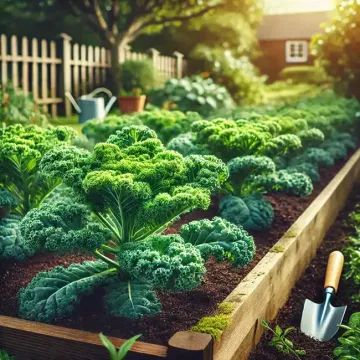History of Kale
Kale has been cultivated for thousands of years and is believed to have originated in the eastern Mediterranean. It was a staple food in ancient Rome and Greece and was later spread across Europe by the Middle Ages. Kale became particularly popular during World War II as part of the "Dig for Victory" campaign, which encouraged people to grow their own food to combat shortages. Today, it is recognized as a superfood, thanks to its dense nutritional profile.
Varieties of Kale
There are several varieties of kale, each with its own unique characteristics. Some of the most popular varieties for home gardens include:
- Curly Kale: The most common variety, with ruffled leaves and a peppery flavor.
- Lacinato Kale (Dinosaur Kale): Known for its dark, textured leaves, this variety has a slightly sweeter taste.
- Red Russian Kale: This variety has flat, fringed leaves with purple veins and a mild flavor.
- Siberian Kale: Known for its cold-hardiness, this kale variety has large, tender leaves.
Growing Conditions for Kale
Kale is a cool-season crop that prefers temperatures between 55°F and 75°F (13°C to 24°C). It can tolerate light frosts and can even become sweeter after exposure to a few frosts. Here are some key growing conditions to consider:
- Soil: Kale thrives in well-draining, loamy soil with a pH between 6.0 and 7.5. Enrich the soil with organic matter, such as compost, to ensure the plants receive adequate nutrients.
- Sunlight: Kale grows best in full sun, but it can tolerate partial shade, especially in warmer climates.
- Watering: Keep the soil consistently moist but not waterlogged. Kale needs about 1 to 1.5 inches of water per week.
Planting Kale
Kale can be started from seeds or transplants, depending on your preference and growing season.
- Starting from Seeds: Sow kale seeds directly in the garden 4 to 6 weeks before the last expected frost in spring. Seeds should be planted about 1/4 to 1/2 inch deep and spaced 12 to 18 inches apart.
- Transplanting: If using transplants, set them in the garden when they are about 4 to 6 inches tall, spaced 12 to 18 inches apart. Transplants can be planted 4 to 6 weeks before the last frost in spring or in late summer for a fall crop.
Caring for Kale
Once your kale is established, it requires relatively low maintenance. Here are some care tips:
- Fertilization: Kale is a heavy feeder, so consider side-dressing with compost or a balanced fertilizer every 4 to 6 weeks to promote healthy growth.
- Weed Control: Keep the area around your kale plants free from weeds, which can compete for nutrients and water. Mulching around the base of the plants can help suppress weeds and retain moisture.
- Pest Management: Common pests that may affect kale include aphids, cabbage worms, and flea beetles. Regularly inspect your plants for pests and use organic pest control methods, such as insecticidal soap or neem oil, as needed.
Harvesting Kale
Kale can be harvested as baby greens when the leaves are about 2 to 3 inches long or allowed to mature fully. To harvest, simply cut the outer leaves, leaving the inner leaves to continue growing. Regular harvesting encourages the plant to produce new leaves and can extend the growing season.
For fall-planted kale, you can leave the plants in the ground through light frosts, which will enhance the flavor. Kale can also overwinter in some climates and resume growing in the spring.
Health Benefits of Kale
Kale is celebrated for its numerous health benefits. It is an excellent source of vitamins A, C, and K, and provides significant amounts of calcium, iron, and antioxidants. These nutrients contribute to better eye health, a stronger immune system, improved bone health, and reduced inflammation. Additionally, kale's high fiber content supports digestive health.
Conclusion
Kale is a versatile and nutrient-packed vegetable that is relatively easy to grow in the home garden. Whether you're a novice or an experienced gardener, adding kale to your garden can provide a continuous supply of healthy greens throughout the growing season. By following these tips for planting, care, and harvesting, you can enjoy fresh, homegrown kale for months to come.

